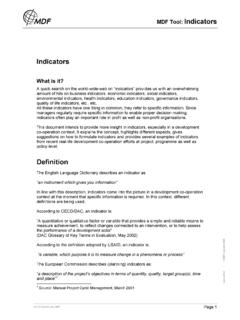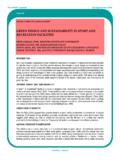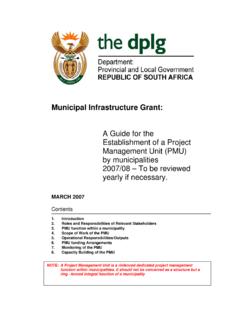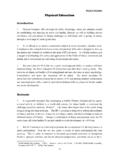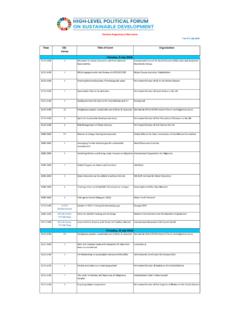Transcription of 12 Training Needs Assessment - Toolkit sport for …
1 MDF Tool: Training Needs Assessment ref:12 Training Needs MDF Page 1 MDF copyright 2005 [This tool assists organisations who want to play a major role in a sports & Development initiative, to identify the need for Training of the staff of their own organisation, in view of the requirements of the sports & Development activities they plan. This tool is not meant to assess the development (and Training ) Needs of the ultimate target group. For the purpose of identifying the ( Training ) Needs of the target group you may use the problem tree analysis tool]. Training Needs Assessment (TNA) What is it?
2 Training Needs Assessment determines the purpose and learning objectives of tailor-made Training in organisations. It forms the basis of focussed design and evaluation of Training sessions. The diagram shows the steps that lead to finding Training Needs , which goes parallel to the analysis of the organisation like of the structures and systems (see chapter 6). Organisational AnalysisTarget group for improving performanceActivities to improveRe-designing policies, tasks, processesKnowledge, skills, attitude neededPresent knowledge skills, attitudePerformance discrepanciesTraining NeedsOn the job Training / guidanceClass room TrainingStructures/ systemsStaffOrganisational AnalysisTask AnalysisDetermining Training Needs MDF Tool: Training Needs Assessment ref:12 Training Needs MDF Page 2 MDF copyright 2005 What can you do with it?
3 Basic (sub-) questions Where are capacity gaps and how can they be bridged? What should the organisation do to make optimal use of increased capacities (rather than that trained persons return to business as usual ) Results Which capacity gaps will we address through Training , and which ones through coaching, or on-the job learning? What is the organisational purpose of Training ? How should the Training session(s) be designed and evaluated? How to use it? Groundwork As shown in the illustration Training Needs Assessment builds on organisation analysis (whether it is strategic orientation or another exercise leading to a clear profile of what should be done). In the context of this Toolkit we can assume that the (prospective) trainer only Needs to be fully informed of the analysis that has already taken place. In other cases the first crucial task of a trainer is to get the problem that is to be solved through Training sharp.
4 TNA also requires clear decisions on who will take up which tasks (as may be expressed in a participation matrix see stakeholder analysis) and the capability of the staff members. Process It is important that those preparing the Training have a complete and shared understanding of the Training purpose and objectives. They should understand the organisations plans and requirements, vis- -vis the current capacity of staff. Managers and the designers of tailor-made Training also need to reach clarity on how trained personnel will use their new competencies. Good Training design therefore implies that the trainers are informed of (if not consulted in) strategic management. Follow up The organisational follow up consists of providing the conditions to trainees to apply their newly gained competencies, and to monitor them. The follow up by the trainers can consist of study of the participant s evaluation and a presentation of his/her manager where concrete action plans are agreed.
5 Both manager and trainer may contact the participants after the Training for impact Assessment . Requirements and limitations This tool discusses the identification of Training Needs , in support of organisational objectives. The same principles apply to tailoring Training or coaching to serve personal development plans. MDF Tool: Training Needs Assessment ref:12 Training Needs MDF Page 3 MDF copyright 2005 The tool limits itself to the identification of Training Needs , and does not discuss the design, implementation, monitoring, evaluation and follow up on Training modules and courses.
6 Practical references Peterson, Robyn, Training Needs Assessment , 2nd ed., Kogan Page practical trainer series, Kogan Page Limited, London, 1998 Example TNA after SOR The below poster shows how Training Needs can be identified in an organisation that has gone through a strategic orientation exercise. Strategic orientation is followed by distribution of tasks. Comparing the (future) tasks and (current) capacities leads to the identification of the capacity gap. This gap can be filled by development activities, of which Training is one. The Training design should consequently refer back to the capacity requirement and gap. The danger is that the trainer forgets this background and develops modules that are too general to hit bulls-eye. Another danger is that the trainer is guided by his/her own biases ( an HRM trainer only diagnosing HRM bottlenecks). Finally the organisation should ensure that trained persons are really charged and supported to apply their (new) skills.
7 Too often trained persons are restrained (in time, support, and monitoring) in putting new competencies into action. After Training OptionsSW4. SOR2. IOM1. Basic Question3. Strategic Options7. Training Needsa. on the jobb. out sourceOpportunities + ThreatsOpportunities + ThreatsStrengths + Weaknesses6. Participation MatrixRRRRRA ctorsAc-ti-vi-tyOtherinterventions MDF Tool: Training Needs Assessment ref:12 Training Needs MDF Page 4 MDF copyright 2005 the trainee should meet with his/her superior, present what he/she learned, and agree on a concrete action plan: Research has proven that this is crucial to Training impact.
8 MDF Tool: Training Needs Assessment ref:12 Training Needs MDF Page 1 MDF copyright 2005 Steps in Training Needs Assessment Organisation Analysis 1. Analyse the clients behind the Training request (see also the tool on client system): Who initiated Who supports (finances, sanctions, monitors, wishes to attend) Who does not support 2. Determine the major problems: Discrepancies between mission and strategy versus input and output Relate problems to systems, structures, staff, management and culture 3. Determine the basic parts (see Mintzberg matrix) to improve. Are they in the: Primary process ( operating core ) Support Development ( techno-structure ) Co-ordination and middle management Strategic competencies 4.
9 Agree on the target group for improving performance: Level: higher management, middle management, staff Which departments Which type of functions/disciplines Task analysis: Identify performance discrepancies 1. Determine task elements: What is the required task of the target group for Training What are the task elements (operational, managerial) 2. Define the required level of performance (in view of the organisation strategy) 3. Determine present level of performance 4. Determine the performance discrepancies Determine Training Needs 1. Determine and address non-competency gaps that have External (institutional) causes and Internal (organisational) causes. For example ineffective or unclear strategies, tasks, processes, styles and culture (see staff conditions algorithm) 2. Determine the competency gaps (in knowledge, skills, attitude and values) What knowledge, skills and attitudes are related to the performance discrepancies (the task elements to improve) What are the relevant and significant differences with present level 3.
10 Decide how to bridge the gaps: Through non- Training Policy/strategy re-design Task re-design Process re-design Through Training On-the-job Training /advise/supervision Coaching/peer review/meetings Formal (Class room) Training

